Managing Chaos
- At December 26, 2013
- By Firstmate
- In Perfect Photo Suite 8, Sports
 0
0
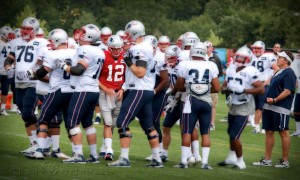 It’s that time of year that my thoughts turn to football. That’s not to say I do not follow it during the rest of the year, but I try to put it into perspective and try not to have it dominate all aspects of life as the NFL may seem to want at times.
It’s that time of year that my thoughts turn to football. That’s not to say I do not follow it during the rest of the year, but I try to put it into perspective and try not to have it dominate all aspects of life as the NFL may seem to want at times.
This photo was taken in the middle of summer during Patriots training camp. Apart from the fact that I am amazed how anything as complex as professional football is and how completely chaotic it appears to a casual observer in the stands and then how the team comes together when one of the coaches blows the whistle, I enjoy the training camp venue simply because I can get probably as close to the team now than at any other time of year. And we all know that for a photographer this proximity is important.
Even though I am close to the practice field during training camp I use my Canon 70-200mm L lens. There is a lot of motion but the summer daylight allows for a faster shutter speed at various aperture settings. Often I wish my angle could be different, but due to the restrictions placed on the fans in the seating area, I have to make do with straight on shots. One way I try to compensate is by depth of field manipulation or special effects in Photoshop. In this shot I again used Perfect Photo Suite 8 to bring out the fact that despite apparent chaos, there are controlling forces (Bill Belichick) and quarterback (Tom Brady) that bring order to everything.
Catching Opportunity
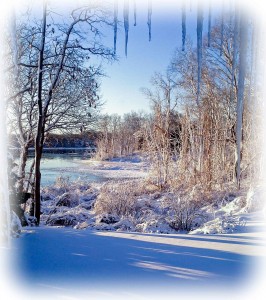 Since my last post snow has arrived on the cove. The photo on the right is actually from mid winter 2012-2013, but it is added now in the spirit of the season– Christmas and all.
Since my last post snow has arrived on the cove. The photo on the right is actually from mid winter 2012-2013, but it is added now in the spirit of the season– Christmas and all.
This is an iPhone 4 shot, and is far from as sharp a photo I really would like to have taken. But, the iPhone was easily available to capture this opportune moment in early morning. I find most of my iPhone photos to lack crispness. I may have a problem with technique, but often I feel it is that the lighting conditions just are often not conducive to the settings on the iPhone.
As with my last photo post I used Perfect Photo Suite 8 to enhance the shot. I’m finding that PPS works best for me as a standalone program rather than a Photoshop add-on (i.e., used from within Photoshop). Often I have a difficult tome figuring out what module I am in in PPS, and what will be saved after I experiment with different effects, etc. I also wish that PPS would be a bit more precise in saving what effects and enhancements I used when I return to previous levels saved by PPS; rather than just stating “Enhancement” for a level, for example.
Capturing Time
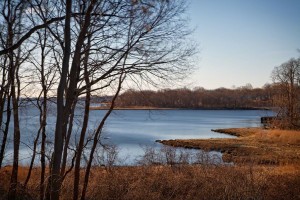 This photograph is actually a confluence of three thematic interests. Copying Joel Meyerowitz’s approach in his book, Cape Light, I have been taking shots of the cove in my back yard in upper Narragansett Bay. If I were enterprising I would title my collection of these shots, Narragansett Bay Light. That may or may not happen.
This photograph is actually a confluence of three thematic interests. Copying Joel Meyerowitz’s approach in his book, Cape Light, I have been taking shots of the cove in my back yard in upper Narragansett Bay. If I were enterprising I would title my collection of these shots, Narragansett Bay Light. That may or may not happen.
However, this shot was my first attempt at long exposure photography using a neutral density filter from Heliopan ND 3.0 (10 stops). I would have liked to have had clouds but then the water would not have been so blue.
Finally, the shot was enhanced using OnOne Perfect Photo Suite 8, to which I had just upgraded. Having used Photoshop for years, getting used to the workflow of PPS 8 takes some getting used to, even though about 80-90% of the interface is the same as Photoshop. This does not mean PPS 8 has the same tool set and precision; it does not. This is not bad or a knock against PPS 8; it’s just that PPS 8 is about doing something different. Each program has their place. Right off the bat I find OnOne’s software more fun to use. I feel a little guilty doing this because to do the same thing in Photoshop would take a lot longer and involve a different level of skills. For this cove photo I used matt Kloskowski’s presets in the Effects module of PPS 8. Obviously, OnOne has packed their Suite 8 software with a host of tools, and each with its own set of adjustments. Some of these I will probably use regularly, while others will just languish.
With the prospect that I may not be upgrading any more to Photoshop due to Adobe’s stance on monthly fees for their software (I disagree with this type of money stream), having tools as contained in PPS 8 provides a viable option.
Window into the Soul
With the 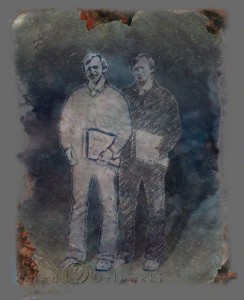 hope of not creating a blog on philosophy, I will continue to lay out my basic beliefs and apparent orientation relating to photography. An extremely fundamental component of what drew me to want to take “pictures” was my hope of making the transcendent immanent; in other words, taking those passing moments of time and making them permanent.
hope of not creating a blog on philosophy, I will continue to lay out my basic beliefs and apparent orientation relating to photography. An extremely fundamental component of what drew me to want to take “pictures” was my hope of making the transcendent immanent; in other words, taking those passing moments of time and making them permanent.
The photo on the right is one of me captured by a good friend at a time in my life when all the disparate forces were coming together for me and I knew I was on the right path to fulfilling my destiny. Those moments are rare, for sure. But there are abundantly rare moments occurring all the time (an oxymoron?) if only we were perceptive to see them, and even more blessed to catch them as a photographic representation. This is what draws me to take photographs. It is analogous to what Eddie Tapp calls the “pocket of light” when he speaks and explains what seeing the light is all about; in a wider sense, it also is analogous to the so called “golden hour” of light during the day. But it is only analogous, but not the window into the soul as I would see it. Some may say that it is the window, simply because if the window does not have the right light the soul will not be seen. I am always searching for both the window and the pocket, after all this is photography and not philosophy.
Even though the self photo on the right was not taken by me, it was crafted by me to bring out this elusive phenomenon of light and soul. There are two selves because of the interplay of light and darkness both in the science and the art of photography. I, obviously, will have more to say on my success or lack there of in capturing this window.
Photography as Visual Absconding
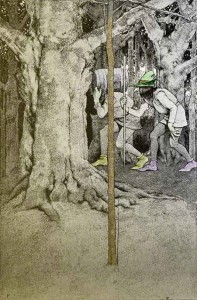 Ever since I took up photography I always felt a little uneasy and guilty when taking pictures. As if I were intruding on whatever was happening, especially when people were present. The act of capturing a scene was not part of the normal flow of life. It seemed that artists with their palettes became part of the scene simply by remaining within it even though they were not a subject on their own canvas. This feeling has persisted and in some ways has hindered my own style and techniques.
Ever since I took up photography I always felt a little uneasy and guilty when taking pictures. As if I were intruding on whatever was happening, especially when people were present. The act of capturing a scene was not part of the normal flow of life. It seemed that artists with their palettes became part of the scene simply by remaining within it even though they were not a subject on their own canvas. This feeling has persisted and in some ways has hindered my own style and techniques.
To become a better photographer technique-wise, I will have to learn to steel myself in order to steal a moment of time from a gamut of moving events. I must learn to abscond, taking that intangibly captured light in my camera and telling myself it is now mine, all the while knowing it truly is not.

Recent Comments